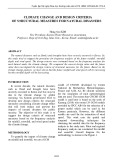
Gan ZK, Long LGG, Zhang DY
Research of Traditional Village
Conservation and Development Planning
in the Perspective of “Multiple-planning”
55th ISOCARP World Planning Congress in Jakarta, Indonesia
International Society of City and Regional Planners
Research Paper
Research of Traditional Village
Conservation and Development Planning
in the Perspective of “Multiple-planning”
Taking Liugou Village in Beijing as an Example
Zhengkun GAN, Beijing University of Civil Engineering and Architecture; China
Lingege LONG, Beijing University of Civil Engineering and Architecture; China
Dayu ZHANG, Beijing University of Civil Engineering and Architecture; China
Abstract
As a primary material carrier of Chinese farming civilization, traditional villages
have the dual attributes of villages and heritage. The traditional village cannot be
regenerated if they were destroyed. Therefore, it is urgent to find a suitable
development model and way out in the context of high-speed urbanization. The
proper planning of traditional villages mainly covers two aspects of protection and
development for a long time. The preparation and management of various types of
planning are also intertwined and even contradictory. “Multiple-planning” is an
effective way to solve the conflicts between different administrative departments
and different types of planning in the current planning process, and also provides a
practical planning idea and method for the future of traditional villages. Firstly, the
research analyzes the existing planning types of traditional villages and points out
that because of the difference of objectives, strategies, and executives, there come
three common problems: The protection measures are not easy to implement; The
development strategies are unsustainable; The planning and implementation are
not connected. These problems directly affected the implementation of planning.
They not only hinder the effective conservation of cultural heritage but also restrict
the revitalization of the village's economic development. Furthermore, the research
discusses the necessity and feasibility of “Multiple-planning” in the conservation
and development of traditional villages and proposes a conservation and
development planning framework for traditional villages from the perspective of
“Multiple-planning.” Finally, the research is taking a traditional village conservation
and development planning of Liugou in Yanqing District of Beijing as an example.
Accomplished valuable planning in the perspective of “Multiple-planning” through
objective and systematic status analyzing, exceptional and feasible conservation
planning, scientific and sustainable development planning.
Key words
Traditional villages, Conservation and development, Cultural heritage, Multiple-
planning
Introduction
Traditional villages, as primary material carriers of China's farming civilization, cannot be
regenerated once destroyed. In the era of high-speed urbanization, it is urgent to find a

Gan ZK, Long LGG, Zhang DY
Research of Traditional Village
Conservation and Development Planning
in the Perspective of “Multiple-planning”
55th ISOCARP World Planning Congress in Jakarta, Indonesia
International Society of City and Regional Planners
suitable development model and way out. For a long time, the proper planning of traditional
villages mainly covers two aspects of protection and development. The preparation and
management of various types of planning are also intertwined and even contradictory.
“Multiple-planning” is an effective way to solve the conflicts between different
administrative departments and different types of planning in the current planning process
and provides a practical planning idea and method for the future of traditional villages.
Governments and planners should face many shortcomings in their past work and actively
explore to find a scientific and practical way for the planning and construction of traditional
villages, keep rural memories and valuable village cultural heritage for future generations.
1 Compilation Model of Relevant Planning for Traditional Chinese
Villages
There are many types of planning for traditional Chinese villages. They can be divided into
three classes from the purpose of preparation, promotion planning for people's livelihood,
industrial development planning, conservation, and remediation planning. Each broad
category contains several small planning types (Table 1).
Table 1 Classification Comparison of Traditional Village Related Planning by Author
Planning
Type
Planning Title
Planning Purposes
Planning Object
Executive
Body
Planning Points
Promotion
Planning for
People's
Livelihood
New Rural Beautiful
Village Planning
Improving the
Quality of the
Village
Villages, Buildings
Government
Taking policy as the
guidance, improving the
basic conditions of
village in an all-round
way
Village Environmental
Improvement Planning
Improving
Environmental
Quality
Villages, Buildings
Government
Focusing on
infrastructure upgrading
Industrial
Development
Planning
Tourism Planning
Developing Tourism
Industry
Villages
Government,
Enterprises,
Villagers
Developing tourism
resources and
expanding village
development Market
Industrial Upgrading
Planning
Promoting
Economic
Development
Industries
Government,
Enterprises,
Villagers
Build the core industry
and enhance the
economic strength of
the village
Conservation
and
Remediation
Planning
Cultural Relics
Conservation Planning
Conserving
Important Cultural
Relics
Cultural relics
Noumenon and
Environment
Government
Conserving the core
value of cultural
heritage
Conservation Planning of
Famous Historical and
Cultural Villages
Conserving Village
Heritage
Villages, Buildings
Government,
Villagers
Conserving the cultural
heritage on a large scale
Traditional Building
Renovation Planning
Repairing
Important Buildings
Buildings
Government,
Villagers
Maintaining the
buildings with high
value
Village Landscape
Planning
Improving
Landscape Quality
Village,
Landscape
Government
Design a rural landscape
with outstanding
characteristics
Traditional village
Conservation and
Development Planning
Conserving and
Developing at the
Same Time
Villages,
Industries
Government,
Enterprises,
Villagers
Establishing archives,
analyzing the current
situation, conserving
heritage, improving
people's livelihood, and
looking for the
characteristics of village
development

Gan ZK, Long LGG, Zhang DY
Research of Traditional Village
Conservation and Development Planning
in the Perspective of “Multiple-planning”
55th ISOCARP World Planning Congress in Jakarta, Indonesia
International Society of City and Regional Planners
1.1 Promotion Planning for People's Livelihood
Objectively speaking, the promotion planning for people's livelihood is usually the most
popular type of villagers. The typical representative of such a plan is the Beautiful Village
Planning. The planning content does not involve the relocation of villages and the transfer of
construction land, with emphasis on the rectification of the village landscape, the
construction of infrastructure and public service facilities. Its purpose is to improve the living
environment and production conditions through correction and finally promote economic
development and social progress. Most of these planning is implemented in a top-down way,
which usually ignoring the characteristics of specific villages. Project selection, site selection,
and construction scale often do not meet the needs of village development, especially when
it comes to heritage conservation and inheritance. It is easy to ignore the repair of
traditional buildings and the preservation of classic features, thus resulting in the
disappearance of traditional elements in the implementation of planning.
1.2 Industrial Development Planning
The starting point and foothold of industrial development planning are in the market
expansion and industrial development of the village. Due to the hollowing and aging of the
rural population, most of the traditional villages have a single industrial structure and a small
development space. The positioning of the industry is mostly concentrated in the tourism of
the tertiary industry. From the perspective of the development of international urbanization,
when most people live in cities, rural pastoral scenery and traditional culture will become
scarce resources, and the continuous appreciation will attract urban residents to come for
sightseeing. Such planning often relies on the core values of traditional villages, led by the
government and enterprises, and the villagers participate to a certain extent. However,
because there is no sustainable integrated of material and non-material traditional cultural
resources, once it is not operated correctly, it will bring irreparable damage to the village.
1.3 Conservation and Remediation Planning
The core of conservation and remediation planning is centered on how to protect the
cultural heritage value of traditional villages. The means adopted are often rigid and have a
significant positive effect on the conservation of villages in the short term. Due to the
attention from the state, most villages in the list of National Traditional Villages have
prepared conservation planning, and their control covers village space patterns, traditional
buildings, historical relics, and environmental factors. Many of the conservation programs
currently in place can technically protect historical buildings and ancient villages as well as
intangible cultural heritage. However, how to meet the needs of the residents' living
modernization while conservation is a problem that has not been completely solved. For this
reason, the state began to require traditional villages to prepare conservation and
development planning to handle the relationship between conservation and development.
2 Common Problems in the Planning of Chinese Traditional Villages
Since the objectives, strategies, and executive bodies of traditional village-related planning
are different, the following three types of problems have arisen. They directly affected the
implementation of the planning and even hindered the effective conservation of cultural
heritage. This is also the contradiction that the “Multiple-planning” should strive to improve.

Gan ZK, Long LGG, Zhang DY
Research of Traditional Village
Conservation and Development Planning
in the Perspective of “Multiple-planning”
55th ISOCARP World Planning Congress in Jakarta, Indonesia
International Society of City and Regional Planners
2.1 Conservation Measures are Single and Difficult to Implement
In the conservation-based traditional village planning, the conserving strategy often only
pays attention to the object ontology, neglects many objective laws of the village
development, and then leads to an inefficiency implementation. In China's urban and rural
planning system, the planning and construction of general villages and towns are managed
by the Ministry of Natural Resources, the material cultural heritage is governed by the
National Cultural Heritage Administration, and the intangible cultural heritage is managed by
the Ministry of Culture and Tourism. Traditional villages have a particular cultural status of
tangible and intangible cultural heritage, lacking guidance, and coordinating from higher
levels of government. For example, because the reduction of construction land can
effectively control the population size and alleviate urban diseases, land supply policy in
China is generally decreasing. When protecting critical cultural relics units, it is often
necessary to vacate some buildings within the scope of conservation, but there is no
reasonable area for subsequent resettlement planning. If the conservation and development
planning does not combine the land use superior planning, it will not be able to create
enough circulation space for conservation. The conservation will eventually not be
implemented.
2.2 Development Strategy Is Not Sustainable
With the acceleration of urbanization, traditional villages continue to suffer from
“constructive, developmental, and tourism” damages. The relevant planning does not
control development in appropriate measures is the root of the problem. Some local
governments have neglected the environmental capacity of traditional villages and just
compiled industrial planning that caters to the needs of society. Coupled with the
spontaneous and decentralized management of the villagers, there has been a severe
homogenized phenomenon in the type of industry and structure of the function. The value
of “characteristic” in rural areas has not been reflected. Such extensive development
strategies continue to impact and erode an accelerated decline of traditional villages.
2.3 Lack of Convergence between Planning and Implementation
The planning implementation of traditional villages is different from another general village
planning. The general village planning is characterized by focusing only on the recent
construction task, the improvement of infrastructure, and environmental remediation. The
planning of traditional villages should pay more attention to the conservation of historical
environmental elements and traditional features, which also puts higher requirements on
implementation. The reality is that the township-level government, as the main body of the
application, lacks professional planning management and supervision and evaluation, and
often focuses on project thinking, focusing only on the specific projects in process. There is
no macroscopic and systematic overall development thinking, which inability leads to
integrate the actual construction of the traditional villages with the planning. As the person
in charge of the planning and preparation, the planner only completed the preliminary
design work, lacked two-way communication with the villagers, and rarely played the role of
dynamic adjustment and feedback during the implementation process. The participation of
the villagers as an object of implementation is not high, the information is also asymmetrical,
and the acquisition sense of villagers is low, too. In summary, planning is only meaningful if it

Gan ZK, Long LGG, Zhang DY
Research of Traditional Village
Conservation and Development Planning
in the Perspective of “Multiple-planning”
55th ISOCARP World Planning Congress in Jakarta, Indonesia
International Society of City and Regional Planners
plays a role in the process of practice. This is also the key to whether planning can exist and
be implemented under the market economic system.
3 The Necessity and Feasibility of “Multiple-planning” in the
Development of Traditional Village Conservation
3.1 Necessity
From the international cognition process of heritage conservation, ICOMOS adopted the "
The Valletta Principles for the Safeguarding and Management of Historic Cities, Towns and
Urban Areas " at the 17th General Assembly in November 2011. It was in a time which politic,
economic, culture, and social realm are facing a period of significant change, and it is the
necessary revision of the Washington Charter. It proposes that the values of historic towns
and their backgrounds should be protected and have integration with the social, cultural,
and economic life of our time. It is not difficult to see from the Valletta Principles that in the
context of sustainable development over the world, to better conserving the material and
intangible historical values of traditional villages, action should be strictly linked to economic
and social development. To improve the quality of the environment and life, we must make
good use of the “Multiple-planning” model.
Judging from the current situation of the conservation and development of Chinese villages,
we are also facing a very severe test. As summarized in the previous article, merely thinking
about the future of the village from the safeguarding level is not even keep up with the pace
of the times, and it is impossible to restore the decline of the village substantially. At the
same time, the previous model faced conflicts between the various departments. The
“Multiple-planning” approach is used to coordinate the value orientation of the ideological
level, coordinate the planning of the technical method level, and coordinate with the main
body of the implementation level. It can provide new ideas for the implementation of
traditional village conservation and development. So far, several provinces have issued
proposals to strengthen the protection of traditional villages and proposed to prepare of the
village “Multiple-planning scientifically.”
Also, the state has proposed to adopt the “One Blueprint Strategy” to optimize the urban
spatial layout for the new urbanization construction many years ago and promote the
“Multiple-planning” used in economic and social development master planning, urban
planning and land use planning. This not only provides a clear demonstration of the
“Multiple-planning” of the traditional village planning but also emphasizes the necessity of
“Multiple-planning” in the future planning of traditional villages from the national level.
3.2 Feasibility
Since 2014, the four ministries and commissions jointly issued the “Notice on Carrying Out
the Pilot Work on Multiple-planning in Cities and Counties.” Twenty-eight cities and counties
across the state have launched the “Multiple-planning” exploration work. Many successful
explorations at the town level have provided valuable references for the current “Multiple-
planning” transformation of traditional villages, significantly increased confidence.
The sustainable development of traditional villages has also received considerable attention
from the Ministry of Housing and Urban-Rural Development. In the basic requirements for








![Đề thi học kì 1 môn Nguyên lý thiết kế nội thất năm 2020-2021 [Kèm đáp án/Hướng dẫn giải]](https://cdn.tailieu.vn/images/document/thumbnail/2025/20250401/lakim0906/135x160/8691743477152.jpg)
![Xu hướng thiết kế nội thất quán cà phê tại Hà Nội [Mới Nhất]](https://cdn.tailieu.vn/images/document/thumbnail/2025/20250228/viinuzuka/135x160/4721740761337.jpg)







![Bài giảng Quản lý vận hành và bảo trì công trình xây dựng [chuẩn nhất]](https://cdn.tailieu.vn/images/document/thumbnail/2025/20251006/agonars97/135x160/30881759736164.jpg)








